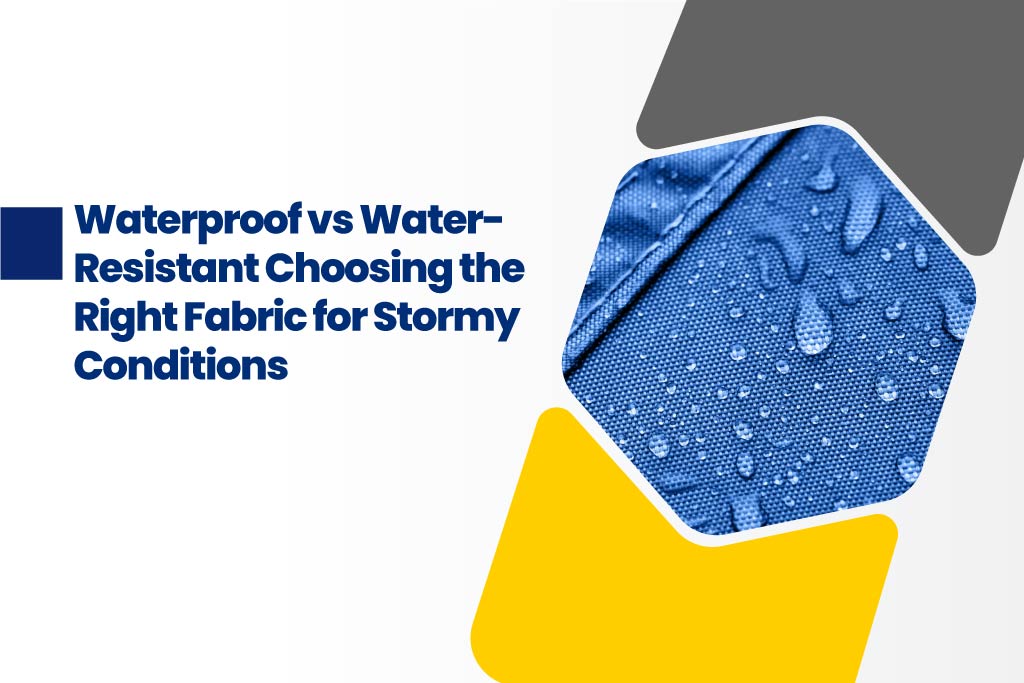Have you ever been annoyed on rainy days for getting wet? You would have probably chosen the best waterproof jacket or water-resistant fabric to thrive on rainy days, right?
But, wait! Have you ever wondered about their key differences and what makes them unique?
They both are almost similar, but the purpose, protection,and performance they serve is different. Read on to explore everything from the key distinctions, and the science behind them, to choosing the right material for your rainy-day needs.
Pursuing the best fashion designing program in the top B.Des Fashion Design colleges in Coimbatore will bring you the practical sides of fashion design along with technological integration and knowledge in unrepentant fashion trend switches from time to time.
Waterproof vs. Water-Resistant
The right choice of fabric makes all the difference in staying dry and comfortable in stormy weather.
Hence, understanding the difference between waterproof and water-resistant materials is crucial for making the right decision.
What is Waterproof Fabric?
Waterproof keeps the water out!
The material formation of waterproof fabric provides an impermeable barrier to water, preventing any moisture from passing through. They are highly water-resistant and, in many cases, they are not a cent percent waterproof fabric as they claim to be.
Multiple polyurethane coatings and synthetic fibers enable waterproof fabrics to lock in moisture and repel water from passing through. Due to this complex process, they are slightly more expensive than water-resistant jackets.
They are designed to keep you completely dry even in heavy rain or harsh weather conditions. They can be non-breathable and uncomfortable sometimes compared to the other.
What is Water-Resistant Fabric?
Unlike waterproof, this fabric resists water penetration and the chances of getting wet are higher. Hence, the materials can repel water to a certain degree but are not entirely impervious to moisture.
They can manage light rain splashes or short exposure to wet conditions but will eventually allow water to seep through if exposed to prolonged or heavy downpours, as it’s designed to resist. Water-resistant is also called hydrophobic, in some cases.
The choice between these two types of fabrics depends completely on the intended use, environmental conditions, and personal preferences.
The Technology Behind Waterproof Vs Water-Resistant Fabrics
Waterproof
Waterproof fabrics are engineered to completely let water out. Multiple combinations of tightly woven fabrics, deep specialized coatings, and membranes help in achieving this condition.
- Membrane Technology
The major material behind the formation of waterproof fabrics is Membrane. Every waterproof fabric incorporates a membrane to block water droplets and allow moisture vapor to escape.
Membranes such as Gore-Tex or eVent have microscopic pores which are used in manufacturing waterproof jackets and other products. This technology ensures breathability while keeping you dry.
- Durable Water Repellent (DWR) Coating
In addition to Membrane, waterproof fabrics often have Durable Water Repellent (DWR) coating on the outer layer.
DWR coating causes water to bead up and roll off the surface, preventing it from soaking in. This coating enhances the fabric’s performance and prolongs its life.
- Seam Sealing
The essential part of waterproof fabrics is Seam Sealing. Even the best waterproof fabric can fail if the seams aren’t sealed. Taped or welded seams prevent water from entering through the tiny holes created by stitching, ensuring complete protection.
These features make waterproof fabrics ideal for extreme weather conditions, such as stormy climates, heavy rain pouring, extreme freeze, or water sports, where staying dry is a top priority.
Water-Resistant (aka Hydrophobic)
Water-resistant fabrics are known for providing a lower level of protection compared to waterproof materials, making them an ideal fit for light rain, short mist, outdoor games, and hiking.
They are typically treated with a light DWR coating to avoid water and prevent quick saturation. The science behind water-resistant fabrics include
- Tight Weave
Water-resistant fabrics are known for blocking water through a tight weave that naturally repels water to some extent. However, they lack the membrane or coating that provides full waterproofing.
- Breathability
Due to the absence of a membrane, water-resistant fabrics tend to be more breathable and comfortable in mild weather conditions. They allow more airflow and prevent overheating, making them suitable for activities that require more movement.
- Lightweight and Flexible
These fabrics are usually lighter and more flexible than waterproof options, making them comfortable for casual wear and activities like hiking or biking in light rain.
You can understand better technological integration in fabric creation, especially waterproof materials in accordance with the global fashion hub through a well-established B.Des curriculum in the best Fashion Designing Colleges in Coimbatore.
How to Choose the Right Fabric
Various factors should be taken into account to make the right choice between waterproof and water-resistant fabrics,
- Weather Conditions
Waterproof fabrics are essential for heavy rain, stormy conditions, tornados, snow, or running wet environments. Water-resistant fabrics may suffice for light showers short drizzle or light cold splashes.
- Activity Level
Waterproof materials are way too less breathable than water-resistant jackets. Besides, water-resistant fabrics often provide better ventilation and comfort for high-energy pursuits.
So, high-intensity activities like running, cycling, or hiking, generate body heat and sweat, which makes breathability crucial. Hence water-resistant fabrics can be the right choice for comfort.
- Duration of Exposure
Duration matters to give you the ease of ventilation and comfort. So, the duration of exposure to wet conditions matters in deciding the right fabric.
For short trips or brief exposure, water-resistant materials might work. For prolonged exposure, like multi-day hikes or expeditions, waterproof fabrics are the safer choice.
- Budget
Waterproof gear is generally more expensive due to the complex technology and materials used. Water-resistant options are known for cost-effectiveness.
Choosing between waterproof and water-resistant fabrics ultimately depends on your specific needs and intended use. Understanding the differences in performance, durability, and comfort will help you make an informed decision.
Karpagam School of Architecture, also known as KARCH, is the Best Fashion Designing Colleges in Coimbatore, thereby bringing students the best-in-class environment, diverse learning opportunities, Industry-based curriculum with world-class faculties, technological advancements, and global career advantages.
Whether you’re braving a storm on a mountain trail or simply commuting to work on a rainy day, selecting the right fabric will ensure you stay dry, comfortable, and ready to take on any weather challenge.






